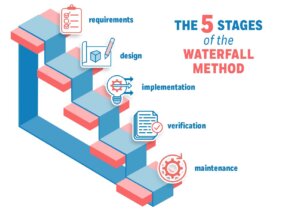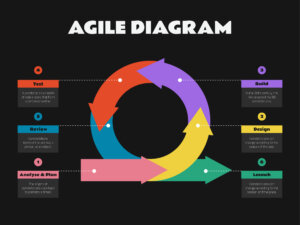The issue of scope creep has bedeviled project managers since the ancient Egyptians wondered if three pyramids might be more impressive than just one. It isn’t a difficult concept to understand. However, heading off scope creep often requires a great deal of effort and expertise.
Key Takeaways: Scope Creep
- Project scope is the project’s goal and the process for achieving it.
- Scope creep in project management is when changes are made to the scope that don’t aid in its successful completion.
- Creep can be caused by stakeholders making requests or team members making unauthorized changes.
- Scope creep can cause a project to fail, so is an important concern of project managers.
- Preventing scope creep requires a clear scope, a method of handling change requests, and fostering communication between team members and other stakeholders.
- There are a wide array of tools to assist in managing scope creep.
What Is Scope Creep?
While scope creep is one of the most common reasons projects fail, there is no single agreed-upon definition of scope creep. Broadly speaking, it refers to the addition of tasks outside the original, defined project scope. Another way to think of scope creep is as uncontrolled or unexpected changes that may be opposed to the requirements of a project.
Some people would add that scope creep only occurs when unauthorized changes are made. By that definition, any scope change approved by someone in authority doesn’t qualify as scope creep. Others have determined that changes of any kind, approved or otherwise, can impact a project’s success and therefore be considered scope creep.
An example of project scope creep might be adding a feature that recommends mechanics halfway through the development of a car buying app. Requirement creep like that might introduce useful new features, but it’s not part of the goal of the project. Additionally, it adds to project cost and time.
To understand scope creep and its effects, we first have to look at the project scope itself.
Project Scope and Product Scope
The scope of a project is both the product it will produce and the process needed to produce it. The initial scope is referred to as the baseline scope, including the scope statement and work breakdown schedule.
The product can be anything from software to a new building. Whatever it is, the product has its own defined scope which needs to be part of the project plan.
Scope creep occurs in both product scope and overall project scope. Either can be a factor in project failure. In general, the more detailed and precise the project scope is, the less likely scope creep is to occur. As a result, the chances of successfully completing a project increases.
Agile Projects
Agile projects is a project management methodology that has been criticized as a sort of organized form of scope creep. When a project manager uses Agile methods, the product scope is not defined at the start of the project. Instead, project teams follow a process of defining and redefining the product throughout the project. That can seem like a recipe for continually redefining scope.
However, this is where separating product and project scope can be helpful. Agile methods generally have fixed resources and schedules, which are initially defined as part of the project scope. Changing either of those in the course of a project could qualify as scope creep.
How To Identify Scope Creep and Its Causes
Some degree of scope creep is often inevitable. Particularly at the rate at which daily life changes in the modern age, project requirements are likely to change in the midst of work. However, it’s the job of a project manager to keep it to a minimum.
Despite that, there is no simple method for identifying scope creep.
Successful project management means accomplishing goals outlined in the project scope within budget and according to schedule. When scope creep occurs, it draws further on resources and takes up more time, but doesn’t contribute toward reaching goals.
Generally speaking, methods of identifying creep involve assessing project progress while monitoring resources. Expending resources without progressing is usually a sign of scope creep. Project management tools along with project management software can be a great aid in this process.
A more effective method of managing creep is often to identify causes of scope creep and then, putting measures in place to control them.
What Causes Scope Creep?
The causes of scope creep on a project can vary depending on the nature of the project itself. Creep in software development may have a different origin than in construction. However, there are some common causes, including:
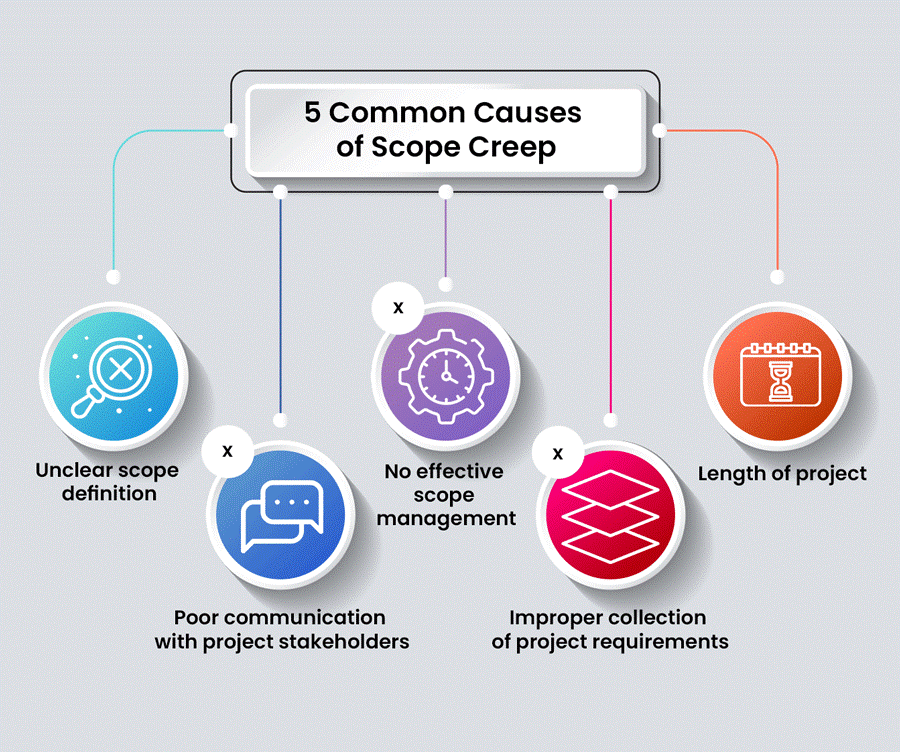
- Unclear scope definition.
- Poor communication with project stakeholders.
- No effective scope management.
- Improper collection of project requirements.
- Length of project.
Unclear Scope Definition
The first, and perhaps most common, cause of scope creep is an insufficiently defined scope. If you don’t know what the goals of the project are, you can’t have a clear idea of how to reach them. Those issues have to be worked out in the midst of the project, leading inevitably to wasted time and resources.
Agile methods are ideal for use in contexts when outside factors could affect the scope during the project. However, Agile projects still require some aspects of the scope to be clearly outlined.
Poor Communication With Project Stakeholders
The project sponsor is the person who will overall be held responsible for the outcome. They also often don’t have the knowledge or time to precisely define every aspect of a project.
Stakeholders are those individuals who either are involved in the project or will be affected by it. They may have agendas or desire features that would draw resources away from primary goals.
Part of a project manager’s job is managing the relationship between interested parties. If that’s not done properly, it is possible to waste time and resources due to disagreements. Too many stakeholders also cause problems, as the more difficult communication becomes, the more likely creep is.
No Effective Scope Management
It may be inevitable that the scope of a project will change. Agile methods were developed specifically because requirements or resources change so frequently during a project. If project managers recognize this and put an organized method in place of changing scope, uncontrolled change can be much reduced.
Improper Collection of Requirements
Another aspect of working with stakeholders is a clear process for collecting requirements. Stakeholders may see opportunities to add new features, find aspects they personally like and wish to be included, or otherwise add ‘requirements’ that don’t actually work toward the overall goal.
A clear process for collecting and assessing requirements can help prevent that wasted effort.
Length of Project
A longer project doesn’t necessarily lead to more scope creep. However, it does mean there is more opportunity for it.
What Mistakes Were Made To Allow It To Persist and Build?
Scope creep tends to stick around for two reasons:
- Unclear scope definition: If it is never clarified, an unclear scope can continue to drive creep.
- No process for incorporating changes: Some changes may be unavoidable. A defined process for making those changes can assess which are necessary and how to alter the project with minimal impact to project timeline and budget.
Fixing scope creep in any particular project usually means addressing these two issues.
How To Fix Scope Creep
The estimated percentage of successful projects varies but is usually around 30%. That means that most projects either fail or are not completed satisfactorily, in many cases likely due to the effects of scope creep. There may be no simple way to mitigate scope creep in project management, but it’s vital to successful completion. Methods for addressing creep include:
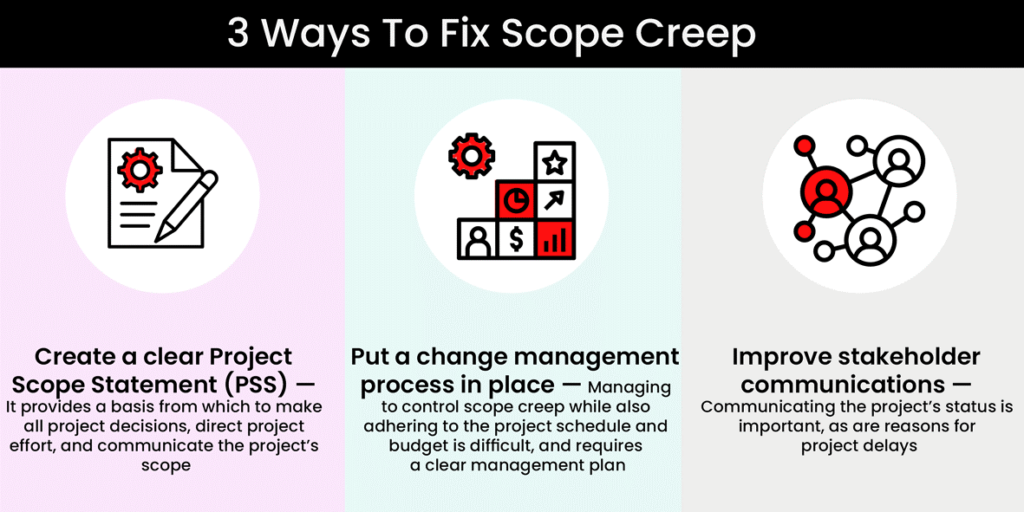
- Create a clear PSS.
- Put a change management process in place.
- Improve stakeholder communications.
Project Scope Statement
The project scope statement (PSS) provides a basis from which to make all project decisions, direct project effort, and communicate the project’s scope. It can also be a way of defining the boundaries of the project. The statement is important when creating a work breakdown structure, a clear project schedule, and a breakdown of project management phases, among many other things.
As a tool for communication, a PSS can foster a better client relationship. It can also clarify when changing requirements or adding additional features would cause scope change. Creating a statement or improving an existing one can help limit change.
Change Management Process
Some scope changes may be inevitable. In some ways, it is in the management of scope creep, project management finds its underlying purpose. Managing to control scope creep while also adhering to the project schedule and budget is difficult, and requires a clear scope management plan.
One of the most important aspects is the process for handling change requests. Requests for changes from stakeholders are a key reason for scope change. A clear process makes it easier to decide what changes are necessary.
Stakeholder Communications
A stakeholder is not just a client or project sponsor. They can also be team members, end-users, and other interested parties. Communicating the project’s status clearly is important, as are reasons for project delays.
A project’s success is greater when new requests for change taper off as the project nears its end. Doing so helps prevent feature creep and prevents the change control process from controlling the entire project. The best way to accomplish that is by collecting all the needed requirements from the start.
A quality project management software may help in improving communications between various team members.
How To Manage Scope Creep
As we’ve mentioned, it may be impossible to entirely prevent scope creep. Instead of trying to figure out how to avoid scope creep, it’s better to have a process to manage scope creep.
The strategies for fixing scope creep we’ve already mentioned can also help prevent and manage it, including a formal change management process, defined PSS, and process for stakeholder communications.
Those are broad approaches to handle scope creep and it might help to focus on some tools for accomplishing those goals.
While project charter and statement of scope are sometimes used interchangeably, they are not quite the same thing. A charter is a document that launches a project and gives it the initial goal. A PSS delves into greater detail and answers questions the charter may not. Creating a PSS is part of the initiating phase of a project.
Creating a Project Scope Statement
Elements of a Scope Statement
A PSS is a bridge between the initial idea and the actual work needed to accomplish it. It fills in the outline provided by the charter with specific practical steps. A PSS includes elements such as:
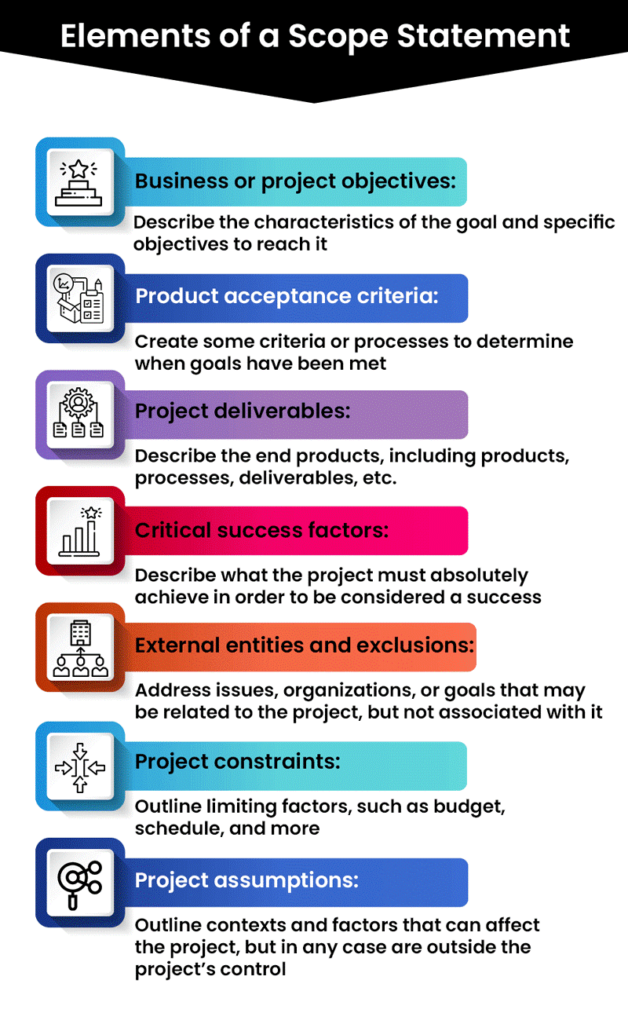
- Business or project objectives: Describe the characteristics of the goal and specific objectives to reach it.
- Product acceptance criteria: Create some criteria or processes to determine when goals have been met.
- Project deliverables: Describe the end products, including products, processes, deliverables, etc.
- Critical success factors: Describe what the project must absolutely achieve in order to be considered a success.
- External entities and exclusions: Address issues, organizations, or goals that may be related to the project, but not associated with it.
- Project constraints: Outline limiting factors, such as budget, schedule, and more.
- Project assumptions: Outline contexts and factors that can affect the project, but in any case are outside the project’s control.
Defining the Project Scope
A PSS is a complex document and creating a clear statement of scope can potentially be difficult. Defining the edges of the scope and developing a plan can both present a challenge. Some tools that can help you clarify scope include:
- Context diagram: Identify outside factors that can impact the project. Recognizing those factors can outline what the project needs to address to achieve goals. It can also identify stakeholders and prevent scope drift.
- Use case diagram: Identifying the needs that have to be met by the project plan can reveal all the additional features that need to be included in the end product.
- Product backlog: Use stakeholder and user feedback to create a wishlist of requested functions. Prioritizing such requests can offer a clear view on scope.
Creating a Change Management Process
If defining the project’s scope is difficult, changing it once the project has begun is even more demanding. Despite that, managing changes to the scope is an imperative part of a project manager’s job. A few basic guidelines can somewhat simplify this challenging task:
- Be lean: Particularly when a project manager is coming in from outside an organization, try to keep the process as simple as possible. Doing so can often keep things moving efficiently and with minimum disruption.
- Properly define the project scope: If a clear PSS isn’t created, how can you know when it’s changing? A clear scope is necessary when managing scope creep.
- Understand sponsor final acceptance: Project sponsors put the project in motion and will often have the final say over its completion. Understanding their requirements allows you to aim project work toward specific goals for success.
- Define change request process: Provide a clear path for change requests to be evaluated and then put into action.
- Document and communicate change process: Outline the process and, vitally, make sure project team members understand it and are on board.
- Manage change: You’ve determined a change is needed, now it’s time to put it into action. This is a complex topic that deserves study of its own scope change.
That covers the high-level goals of a change control process. However, in practical terms, it also has to fulfill several functions to be successful, including:
- Prevent changes outside the change control system.
- Review requests quickly.
- Maintain the integrity of the baseline scope.
- Decide which requests to approve.
- Manage each approved change request.
- Coordinate approved changes through the project.
- Document the changes made.
Understanding Stakeholders and Requirements
Managing the communication between project team members and key stakeholders, as well as managing a client relationship, are arts in themselves. However, there are a few tools that can help. Some can help you understand stakeholders in a more abstract way, while others bring them together to discuss issues directly. Described below are tools for both approaches.
Facilitated Workshops
A common tool in software development is the joint application design workshop. Similar gatherings can be used to help develop a complete understanding of scope for other types of projects, as well. The goal is to gather representatives from the different groups of stakeholders to discuss the project and reach a consensus.
A neutral facilitator can lead, which may not be the project manager, and may include a variety of activities to aid in communication. As an example, the participants may identify the strengths and weaknesses of the project, as well as any opportunities or threats.
Workshops should end with outlining the next steps in the project’s progress. A collaborative process of this sort provides a roadmap for the project team and project managers that can help in preventing creep.
Stakeholder Analysis
Stakeholder analysis is a range of tools used for several reasons. The goal is identifying stakeholders and understanding both the communicated and uncommunicated requirements they have for the project.
Stakeholders are at the heart of every aspect of project management. Analysis helps the project team best align their efforts with the project’s goals. Tools used in stakeholder analysis include:
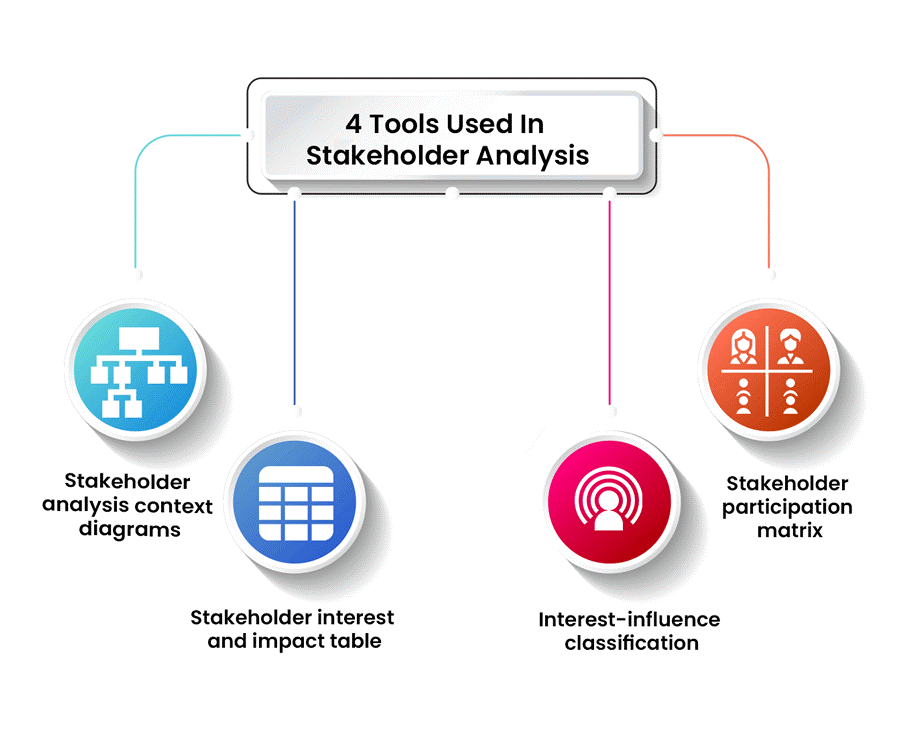
- Stakeholder analysis context diagrams.
- Stakeholder interest and impact table.
- Interest-influence classification.
- Stakeholder participation matrix.
Frequently Asked Questions (FAQs) for What Is Scope Creep
Final Thoughts: So What Is Scope Creep?
Scope creep has been the cause of any number of failed projects. Managing it can seem like an incredibly expensive game of whack-a-mole. However, with a clear plan and some elbow grease, you can avoid scope creep or even turn it into a positive.
 Sections of this topic
Sections of this topic



